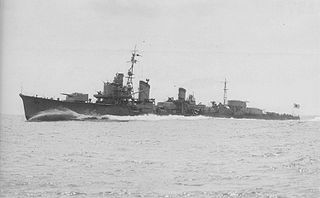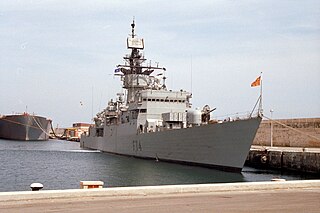
The Santa María class of guided missile frigates is the Spanish Navy's designation for six warships based on the United States Oliver Hazard Perry-class frigates. Spanish ships have a slightly bigger beam and were built with a greater weight reserve for future improvements. Other changes from the basic model include Meroka replacing Phalanx and a RAN-12L air search radar to provide low horizon coverage against sea skimmers cueing the Meroka CIWS mount. The Nettunel EW suite replaced the SLQ-32 system fitted aboard US ships. The first ship Santa Maria entered service in 1986.

The Daphné-class submarine was a class of the diesel-electric powered submarines designed and constructed for the French Navy in 1964. Marketed by the French government for the export market, the Daphné design went on to serve in South Africa while there were subclasses based on the Daphné design that were commissioned in the navies of Pakistan, Portugal, and Spain. The submarines were in operation between 1964 and the late 1990s, their service lives being extended to fill the capability gap until the newer French nuclear submarines became available. Two French submarines were lost and a third was sunk, but was salvaged.

USS Hayler (DD-997) was a Spruance-class destroyer that served in the United States Navy from 1983 to 2003. Named for Vice Admiral Robert W. Hayler (1891–1980), she was the last ship of her class.

Yūgumo(夕雲, "Evening Clouds") was the lead ship of her class of destroyer built for the Imperial Japanese Navy during World War II.

Hayanami was a Yūgumo-class destroyer of the Imperial Japanese Navy.

Akishimo was a Yūgumo-class destroyer of the Imperial Japanese Navy.

España was a Spanish dreadnought battleship, the lead ship of the España class, the two other ships being Alfonso XIII and Jaime I. The ship was built in the early 1910s in the context of a cooperative defensive agreement with Britain and France, as part of a naval construction program to restore the fleet after the losses of the Spanish–American War. She was the only member of the class to be completed before the start of World War I, which significantly delayed completion of the other vessels. The ships were armed with a main battery of eight 305 mm (12 in) guns and were intended to support the French Navy in the event of a major European war.

The Baleares class were a group of five frigates built for the Spanish Navy in the late 1960s and 1970s. The ships were a modified version of the American Knox-class frigates. The key differences are the replacement of helicopter facilities by a medium-range surface-to-air missile system and associated radars. Constructed between 1968 and 1976, the Baleares class began entering service in 1973 and formed the 31 Escort Squadron, based at Ferrol. The five ships were upgraded several times during their service lives. The ships were retired beginning in the mid-2000s and replaced by the Álvaro de Bazán-class frigates on a one-to-one basis.

The Atami-class gunboats were a class of riverine gunboats of the Imperial Japanese Navy. The class consisted of two vessels, Atami (熱海) and Futami (二見). Designed for service on Chinese rivers, they were an improved version of the Seta class. They were constructed by Fujinagata at Osaka, Japan in 1928 to 1930. The gunboats served in the Second Sino-Japanese War and World War II until their surrender in 1945. They were taken over by the Republic of China and renamed Yung Ping and Yung An respectively. Both ships were captured in 1949 by Communist China during the Chinese Civil War.

The Yamashio Maru class consisted of a pair of auxiliary escort carriers operated by the Imperial Japanese Army during World War II. They were converted from tankers. Only the name ship was completed during the war and she was sunk by American aircraft before she could be used.

The Guadiana class was a class of four destroyers employed by the Portuguese Navy between 1913 and 1942. This class is often alternatively referred as the Douro class.

Baleares (F71) is the lead ship of five Spanish-built Baleares-class frigates, based on the American Knox class design, of the Spanish Navy.

Andalucia (F72) is the second ship of five Spanish-built Baleares-class frigates, based on the American Knox class design, of the Spanish Navy.

Cataluña (F73) is the third ship of five Spanish-built Baleares-class frigates, based on the American Knox class design, of the Spanish Navy.

Asturias (F74) is the fourth ship of five Spanish-built Baleares-class frigates, based on the American Knox class design, of the Spanish Navy.

Reina Regente was a protected cruiser built for the Spanish Navy in the 1900s, the only member of her class. She had a very lengthy construction period, being laid down in 1899, launched in 1906, and finally completed in 1908. The last cruiser built in Spain for nearly twenty years, she was armed with a battery of ten 15 cm (5.9 in) guns and was capable of a top speed of 20 knots. Reina Regente's career was uneventful, the result of limited naval budgets and Spain's neutrality during World War I. In the early 1920s, she was employed as a training ship until she was discarded in 1926.

NRP Douro was a Guadiana-class destroyer built for the Portuguese Navy in the 1910s.

NRP Guadiana was the lead ship of the Guadiana class of destroyers built for the Portuguese Navy in the 1910s.

NRP Vouga was a Guadiana-class destroyer built for the Portuguese Navy in the 1910s and early 1920s.
This page is based on this
Wikipedia article Text is available under the
CC BY-SA 4.0 license; additional terms may apply.
Images, videos and audio are available under their respective licenses.


















